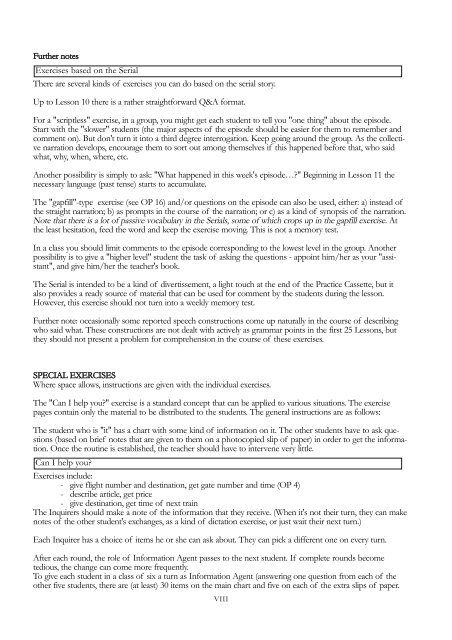O R A L P R A C T I C E Lessons 1 - 25 - Shenker
O R A L P R A C T I C E Lessons 1 - 25 - Shenker
O R A L P R A C T I C E Lessons 1 - 25 - Shenker
Create successful ePaper yourself
Turn your PDF publications into a flip-book with our unique Google optimized e-Paper software.
Further notes<br />
Exercises based on the Serial<br />
There are several kinds of exercises you can do based on the serial story.<br />
Up to Lesson 10 there is a rather straightforward Q&A format.<br />
For a "scriptless" exercise, in a group, you might get each student to tell you "one thing" about the episode.<br />
Start with the "slower" students (the major aspects of the episode should be easier for them to remember and<br />
comment on). But don't turn it into a third degree interrogation. Keep going around the group. As the collective<br />
narration develops, encourage them to sort out among themselves if this happened before that, who said<br />
what, why, when, where, etc.<br />
Another possibility is simply to ask: "What happened in this week's episode…?" Beginning in Lesson 11 the<br />
necessary language (past tense) starts to accumulate.<br />
The "gapfill"-type exercise (see OP 16) and/or questions on the episode can also be used, either: a) instead of<br />
the straight narration; b) as prompts in the course of the narration; or c) as a kind of synopsis of the narration.<br />
Note that there is a lot of passive vocabulary in the Serials, some of which crops up in the gapfill exercise. At<br />
the least hesitation, feed the word and keep the exercise moving. This is not a memory test.<br />
In a class you should limit comments to the episode corresponding to the lowest level in the group. Another<br />
possibility is to give a "higher level" student the task of asking the questions - appoint him/her as your "assistant",<br />
and give him/her the teacher's book.<br />
The Serial is intended to be a kind of divertissement, a light touch at the end of the Practice Cassette, but it<br />
also provides a ready source of material that can be used for comment by the students during the lesson.<br />
However, this exercise should not turn into a weekly memory test.<br />
Further note: occasionally some reported speech constructions come up naturally in the course of describing<br />
who said what. These constructions are not dealt with actively as grammar points in the first <strong>25</strong> <strong>Lessons</strong>, but<br />
they should not present a problem for comprehension in the course of these exercises.<br />
SPECIAL EXERCISES<br />
Where space allows, instructions are given with the individual exercises.<br />
The "Can I help you?" exercise is a standard concept that can be applied to various situations. The exercise<br />
pages contain only the material to be distributed to the students. The general instructions are as follows:<br />
The student who is "it" has a chart with some kind of information on it. The other students have to ask questions<br />
(based on brief notes that are given to them on a photocopied slip of paper) in order to get the information.<br />
Once the routine is established, the teacher should have to intervene very little.<br />
Can I help you?<br />
Exercises include:<br />
- give flight number and destination, get gate number and time (OP 4)<br />
- describe article, get price<br />
- give destination, get time of next train<br />
The Inquirers should make a note of the information that they receive. (When it's not their turn, they can make<br />
notes of the other student's exchanges, as a kind of dictation exercise, or just wait their next turn.)<br />
Each Inquirer has a choice of items he or she can ask about. They can pick a different one on every turn.<br />
After each round, the role of Information Agent passes to the next student. If complete rounds become<br />
tedious, the change can come more frequently.<br />
To give each student in a class of six a turn as Information Agent (answering one question from each of the<br />
other five students, there are (at least) 30 items on the main chart and five on each of the extra slips of paper.<br />
VIII



